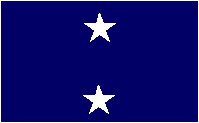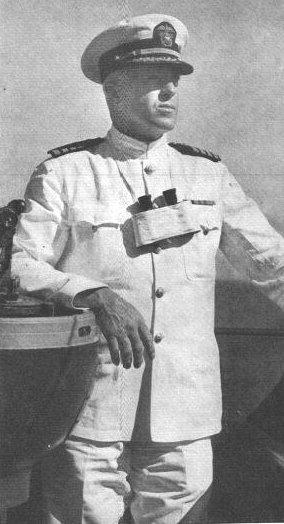


Rank and service:
Rear Admiral, U.S. Navy.
Born: 26 July
1892, San Francisco, Calif.
Appointed from:
California.
Entered service at:
Oakland, Calif.
Other Navy award:
Distinguished Service Medal.
He graduated from Annapolis in 1911, number 38 in a class of 193 which included Norman Scott, who also became a Medal of Honor winner at Guadalcanal. He was initially attached to the armored cruiser California, where he commanded an eight-inch turret, then to the desroyer Truxton as engineer officer, eventually becoming its commander.
In November, 1916 he became engineering officer of cruiser New Orleans. Upon the outbreak of war, New Orleans was transferred to the Atlantic where she did convoy duty between New York and the Med. His tour ran out in November, 1918 right at war's end, and he plunged into the peacetime navy of laid-up ships and pared-down ranks. He persisted, and eventually won assignment to the new battleship Idaho as fire control officer. Over the next fifteen years there followed tours on the battleships Colorado, Mississippi, Pennsylvania, and finally California, on the last of which he worked up to gunnery officer on the staff of the Commander, US Fleet, Admiral Leigh.
In 1936 he became exec of the heavy cruiser Portland, where he performed exceptionally well. In the normal course of events Callaghan would have next become a four-striper, but unusual circumstances intervened. Ross McIntire, President Roosevelt's personal physician, had served aboard New Orleans with Callaghan, had kept in touch with him over the years, and now recommended him to the president as his Naval aide. Roosevelt also remembered Callaghan from meeting him in 1919 at the Bureau of Navigation, and so, apparently very much contrary to his wishes, Callaghan found himself as Naval aide to the president. This shore duty at a point in his career when advancement depended on his command of a major vessel distressed him deeply, but he tried to make the best of it, fulfilling his diplomatic and other duties, and taking a hand in the development and outfitting of the fleet's ships with the 40 mm Bofors antiaircraft cannon.
In the spring of 1941 he pleaded for sea duty, and the president released him to command the heavy cruiser San Fransisco. A year later he was assigned as a rear admiral to Vice Admiral Robert Ghormley as Chief of Staff. Ghormley had recently been moved from his post as naval attache in London to head the new Southwest Pacific Command. His responsibility in the aftermath of the Midway triumph was to develop an offensive campaign beginning the recapture of the vast territories lost to the Japanese. That was the genesis of the Guadalcanal campaign.
In the wake of the Savo Island disaster, Ghormley was replaced by Bull Halsey, who promptly put Callaghan back into San Francisco. In early November the task force commanded by Callaghan escorted a large transport and supply convoy headed by Admiral Kelley Turner. In the early afternoon of November 12 the Japanese attacked from the air with 32 torpedo bombers, hoping to wreck the American combat vessels and clear the way for transports due that night to land thirty thousand Japanese reinforcements. Astonishingly, all but one of the planes was knocked down by the antiaircraft guns of the fleet and the Cactus Air Force. San Francisco herself suffered the major damage when a crashing Japanese plane hit one of the ship's rear turrets.
Turner then combined the two small task forces--Callaghan's and Scott's-- into a single fleet consisting of 2 heavy cruisers, San Francisco and Portland, three light cruisers, Helena, Atlanta and Juneau, and eight destroyers. These he sent off to meet the oncoming Japanese invasion force, and try to stop them. That night, in what has been called "the most furious surface action of the entire war," they succeeded; the Japanese turned back. Callaghan and his classmate Norman Scott, aboard Atlanta, were both killed in action.
Admiral Callaghan and three members of San Francisco's crew were awarded Congressional Medals of Honor. Callaghan's citation reads: